Armed soldiers guard the Israeli pavilion, stamping out their cigarettes in the pale Venetian dust. The doors are locked. The artist probably had no choice but to close her installation, given the unending atrocities. A notice in the window states that the pavilion will only open “when a ceasefire and hostage release agreement is reached” –though Ruth Patir’s film on fertility is still hazily visible within. As one curator quipped, henceforth all art will be blackmail.
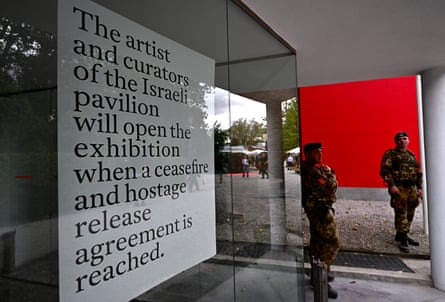
The joke is on the impotence of the gesture. The pavilion would have been picketed or attacked had it stayed open – thousands of artists have already tried in vain to have it closed, via open letter to the organisers – and who is listening in the Middle East anyway? As old Biennale lags observe, even Russia recused itself in 2022 after the invasion of Ukraine, and has loaned its pavilion to Bolivia this time around (though the doors were firmly locked there, too, on preview days).
The German pavilion, not incidentally, is showing the Israeli artist Yael Bartana, making the point that artists are hardly synonymous with nations, and German-born Ersan Mondtag. But Germany is forever picking over its own past, here, with fitful self-consciousness. The mound of dirt currently dumped against the facade of the pavilion directly recalls Hans Haacke’s hacking up of the Nazi-era floors in 1993.
But this dirt is an intimation of the earthen tower that rises inside, setting for an extraordinary memoir of his Turkish immigrant grandfather by Mondtag, a theatre director. Visitors queue to enter into an atmosphere of drifting dust, ascending from a broken workshop in the basement via spiral stairs to a cracked kitchen and ghostly bedroom where a sleeping female actor suddenly wakes to a ringing phone. The news is shocking, and so is the experience of finding oneself part of a promenade performance that leads to the tragic tale of his death. Bartana’s digital projections of spaceships, by contrast, are just noisy dissonance.

The 60th edition of the Venice Biennale is solemn, concerned, occasionally didactic. The oligarchs and their borscht-coloured megayachts are long gone, along with conspicuous wealth and celebrity sightings – dwindled by war, pandemic, austerity, zeitgeist. The living artists (and many of the dead, museumised in the vast central pavilion) are preoccupied by colonialism, migration, queer and Indigenous rights, climate crisis and the restitution of ancestral objects.
Spain has history lessons literally written all over the paintings in its so-called Migrant Art Museum (many of them parody old masters) by Peruvian artist Sandra Gamarra. Where are the local people in these colonial landscapes and lavish family portraits, she asks? Sometimes the message is explicitly sententious. “Transbody is to normative heterosexuality what Palestine is to the west: a colony whose extension and form is perpetuated only through violence.”
The Netherlands presents Congolese figures made of cocoa, palm oil and sugar, alongside the live-streamed return from an American museum of the historic wooden effigy of a Belgian colonial officer to Lusanga. This man ordered the rape of a local woman in the 1930s, so the return of this angry “power object” is a form of reparation. And the sale of their figures, what is more, has allowed these Congolese sculptors to buy back some of the land their families once worked.
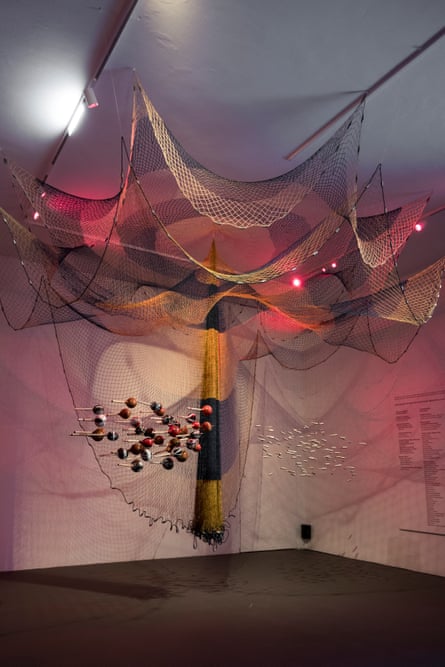
Brazil’s pavilion – retitled the Hãhãwpuá, after the country’s pre-colonial name – has exhilarating installations by the Indigenous artist Glicéria Tupinambá and others. A flock of maracas hang midair, in equal tension with a hailstorm of bullets. Feathered figures turn their magnificently coloured backs to us, in memory of the sacred manteles now lost to western museums. A confetti of letters shows Tupinambá’s tireless attempts to get them back.
There is more writing on the wall in Jeffrey Gibson’s US pavilion, with its trippy, ultra-bright art, conflating hints of pop, psychedelia and the artist’s own Cherokee-Choctaw heritage. Gigantic figures in rainbow ribbons wear beaded tunics inscribed with slogans. Incontrovertible propositions – we want to be free, we are made by history – are painted in eye-popping colours on every surface. Graphically quick and simple, Gibson’s art lends itself perfectly to the badges staff are handing out.
By contrast, John Akomfrah’s cycle of eight multiscreen films at the British pavilion – or cantos, as he calls them, in homage to Ezra Pound – runs to more than five hours. If one only had the time; which is the very river that streams through it all. You enter via the basement to the sound and vision of water ebbing and flowing, through English landscapes, over submerged clocks and other strange riddles, across the faces of the long-dead Tudor courtiers in Holbein’s stupendously sensitive drawings.
Upstairs, like Holbein before them, other immigrants arrive in Britain, from Africa and the Caribbean. Scenes from their lives appear in degraded period footage, or as performed by actors positioned like chess pieces in the rolling green landscape. Each scene hangs before you like a picture, then quickens into motion before cross-fading with another. This is imagist poetry by other means.
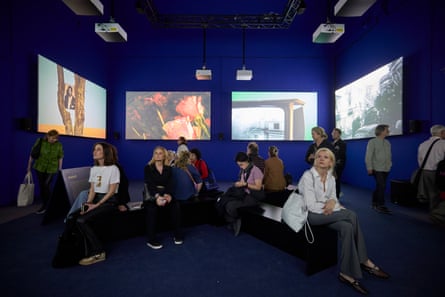
The soundtrack is exquisite, a rising and falling of ticking clocks, chiming bells and human voices, carried by swelling harmonies. Akomfrah lingers on the beauty of human faces, even in suffering, even in death, and the quality of his attentiveness is wonderfully absorbing, an antidote to the fast art of the Biennale. But his installation cannot contain itself, spreading further and further to accommodate Chinese poetry, African history, eventually ecological politics and somehow, fatally, putting everything on exactly the same level.
The colossal show at the heart of each Biennale, filling the central pavilion and overflowing into the Arsenale, is this year curated by Adriano Pedrosa, director of Museu de Arte de São Paulo. Pedrosa is looking at the overlooked: the artists of the global south whose names may be still so unknown. It opens with a terrific gallery of brilliantly coloured modernist paintings and tapestries, many of them by women, including the late, great Cuban artist Carmen Herrera; and it runs all the way through 20th-century bark paintings and textiles, coruscating electronic art and the witty queer mosaics of the Lebanese artist Omar Mismar. There are also, alas, too many weak pastiches of European movements, which seems to undermine the overall objective.
The phrase Foreigners Everywhere (title of this show, and of the whole Biennale) appears all over the city on posters; and on the glowing neon signs in a chorus of different languages that reflect like Christmas lights in the remotest waters of the Arsenale. Perhaps it plays into the hands of Italy’s rightwing government, as Anish Kapoor has objected: a naive attempt to turn around a racist anti-immigration slogan. But the best experience of the 60th edition involves the opposite – the discovery of what it is to be someone from elsewhere.

It is in Bouchra Khalili’s The Mapping Journey Project, in the main Arsenale show – eight screens showing disembodied hands, each tracing a young man’s unbearable sisyphean attempts to get out of Afghanistan, say, on an old-fashioned world map. Desperate journeys on foot or by bus, followed by every kind of reversal, sometimes over several years, yield up apple pickers for France or cleaners for London, whose stories no one ever knows. In one film, a young Palestinian maps his convoluted passage from Ramallah to East Jerusalem, negotiating all of the Israeli checkpoints.
Poland has given its pavilion to a group of Ukrainian artists, whose film installation Repeat After Me presents survivors of bombings in Kyiv, Lviv and Mariupol simply trying to describe the sounds of the horrendous range of different missiles raining down upon them, and then reproducing them in shocking plosives. The actuality of this experience is screened at the Ukrainian pavilion in the Arsenale: what it is like inside the buildings we see decimated on the news. A woman sits fearlessly smoking a cigarette while her jack russell cowers, metal beams toppling around her.
At the Nigerian pavilion, Ndidi Dike’s archive of 736 black police batons lie like severed legs in a morgue, each labelled with the name of someone beaten to death in police custody. Some batons have no tag: as if the deceased was a John Doe, or some poor victim in the future.
In the Romanian pavilion, Şerban Savu’s pensive and fresco-pale paintings show workers excavating old sites, bringing in the harvest or repairing church paintings. Returning from the fields, fishing the rivers: this is life and leisure after (and perhaps pre-) communism: each snatched scene made eloquently permanent.
after newsletter promotion
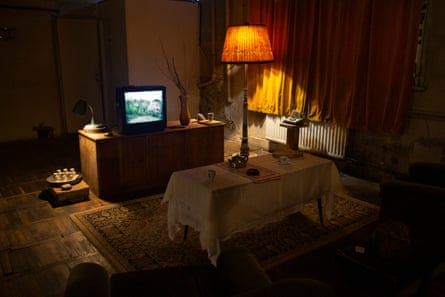
The greatest revelation was a remote pavilion on the water’s edge opposite Giudecca, where artists and historians have found a way to bring forth a hidden chapter of Bulgaria’s past. The scene is a dim house of battered chairs, truckle beds and old cabinets, their drawers filled with earth and lichen, as if the outside had somehow got inside. Images of dark forests and rivers flicker intermittently across the furniture, from which voices sporadically emit. Have you somehow activated them yourself?
What you hear is the testimony of the last survivors of a communist forced labour camp on a Bulgarian island that only closed in 1989. Every pause, every word and breath is absolutely vital. You are intimately drawn into the knowledge of it all through the material scene around you – the scent and touch of each object, the straining to hear every quiet voice, the shifting light. This is the most delicate and elegiac expression of a terrible history.
Ten must-see pavilions
Egypt Wael Shawky’s marvellous film-cum-opera allegorises the incident in an Alexandrian street that led to British occupation, complete with dancers, chorus and donkey.
Bulgaria Profoundly moving revelations about the country’s Communist-era history transmitted through the furniture in a typical Bulgarian home.

Japan Yuko Mohri delights with an eccentric son-et-lumière installation that creates music out of plates of fruit.
Denmark Inuuteq Storch’s lyrical black and white photography documents the lives of Greenlanders in this staggering landscape, which was one of Denmark’s last two colonies.
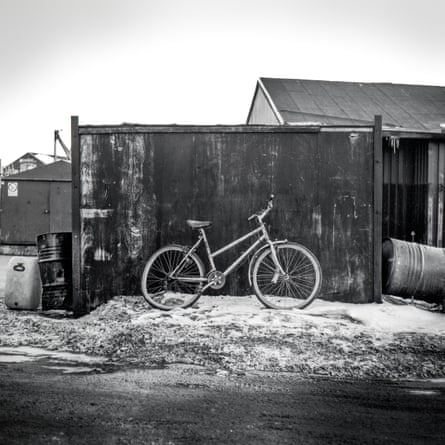
United Kingdom John Akomfrah’s absorbing film cycles, complete with swelling music, ponder the links between migrants to England, from Holbein to the Windrush generation.
Ukraine Mordant screen tests for actors hired to play the role of “acceptable” Ukrainian refugees, from university professors to hard-working mothers.
Benin Inaugural pavilion in the Arsenale, featuring everyday objects cast in spectral glass and Romuald Hazoumè’s magnificent ceremonial hut fashioned out of old petrol cans.

Romania Șerban Savu’s pale and pensive paintings conjure scenes of contemporary Romanian workers at labour and leisure.
Malta Dissecting AI with his own eye-generated drawings, Matthew Attard conjures ancient ghost ships on the seas around his home in the contemporary island.
Serbia Aleksandar Denić transforms the pavilion into a parallel city, complete with bar, shops and toilets, strangely familiar yet eerily disconcerting. LC
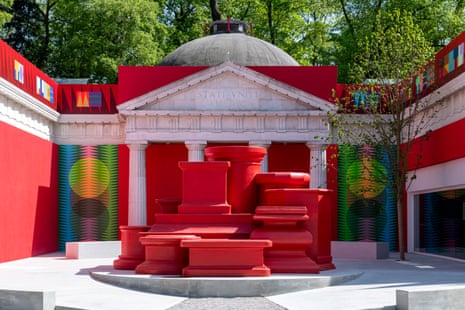
Comments (…)
Sign in or create your Guardian account to join the discussion